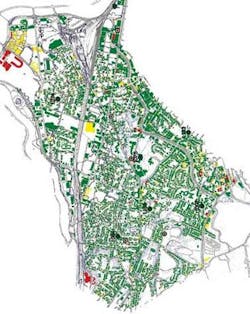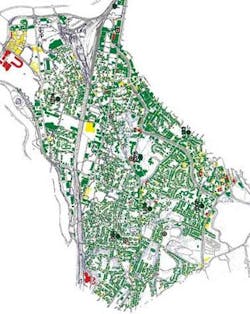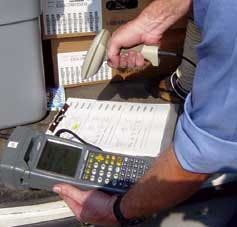Water Utility AMR Deployments Continue to Accelerate
By Donald L. Schlenger
Amid concerns about lean municipal budgets and drought-impacted water utility revenues in parts of the continent, annual shipments of AMR units to North American water utilities grew more than 27% in 2003. As of the end of 2003, there were more than 4,400 separate AMR projects, and about 15% of all the water meters in North America had been equipped with AMR devices, up by about 32% over the end of 2002.
These numbers do not reflect a huge number of units under contract but not yet shipped. For example, Greater Cincinnati Water Works had installed only about 20,000 of the 225,000 units slated for its 4-year AMR project. By the end of 2003, Las Vegas Valley Water District had installed about 100,000 of its more than 300,000 projected units. While the announcements of new AMR projects among the largest water utilities have slowed, the level of AMR activity among smaller water utilities is high.
This growth has attracted investors, and the vendor marketplace has been changing. In 2003, Roper Industries, a diversified industrial engineered products company, purchased Neptune Technology Group. Meanwhile, The Jordan Company, L.P., acquired the Invensys metering systems business, now known as Sensus Metering Systems. These companies are intent upon advancing their technologies to grow this business. Smaller venture capital firms have been exploring positions in certain water utility AMR vendors, and some new companies are introducing new, more technologically advanced products to the market.
Second Generation Mobile AMR
Radio-based systems from well-established companies like Itron, designed to obtain periodic (e.g., quarterly or monthly) readings, dominate the installed base of AMR units and continue to lead annual shipments. Meanwhile, a "second generation" of AMR equipment, characterized by more memory and data processing capability in the meter and meter interface unit (MIU), is capturing the attention of some utilities. These units incorporate more memory and the ability to "sample" readings from the meter on a frequent basis. Coupled with high-resolution encoder or electronic pulsing meter registers, they enable additional capabilities, such as: —
• Load profiling. Some AMR units can store hourly (or more frequent) consumption over a month or more, available for downloading by the meter reader.
• Consumption blocks. The cumulative consumption in three or four portions of the day (e.g., morning, afternoon, evening and nighttime) can be provided.
These capabilities can help utilities with:
• Water conservation. Customers can be shown load profile data as part of a conservation education program. Data from the system can be used to monitor and enforce outdoor irrigation schedules.
• Ensuring meters are of the right size and type. For example, the McKinney (TX) Water Department used hourly consumption data to determine that some of its meters were undersized and significantly under-registering high flows.
• Dispute resolution. Customers who are concerned about unusually high bills can be shown their consumption history. In many instances, they recall the circumstances (filling the pool, lots of lawn watering, houseguests) that created the "high" bill. Or, they may be shown that they have a leak.
— Additional services to customers, such as "watchdog service." With this technology, the utility may be able to notify customers about unusually high consumption and potential leaks before they are surprised by the bill.
Fixed Radio
Fixed radio systems constitute one of the fastest growing segments of the water utility AMR market. Installations in Boston, and Washington, DC, are swelling the numbers already created by Pittsburgh, Jacksonville and several other utilities. These systems permit utilities to obtain consumption information much closer to the time when it occurred, and enable such services as instant final reads, as well as providing most of the advanced capabilities mentioned above.
Other advances are making AMR more attractive to utilities:
• Longer battery life, which extends equipment lives, and enables some manufacturers to offer extended warranties on AMR equipment.
• Decreasing component costs. AMR data collection devices are becoming smaller, more convenient and economical. Utilities can afford to spread the cost of the reading equipment over a smaller number of meters, making smaller deployments practical.
• New meters. Relatively new dial-position (or "absolute") encoders from Hersey and Badger are joining the ranks of encoders from AMCO, Sensus and Neptune, giving utilities more choices.
• Better performance and reliability in difficult environments, such as meter pits and vaults.
• Optical retrofits. At least one manufacturer offers optical pickups to retrofit meters the utility does not want to change.
AMR Business Cases More Sophisticated
With an increasing body of industry experience, and help from vendors and consultants, water utility managers are developing more sophisticated business cases for AMR, reaching further to incorporate more benefits. They are recognizing that AMR-based consumption data is valuable for optimal meter management, rate setting, loss control and distribution system design, and that customer satisfaction and security are important benefits. They are taking a "life cycle" approach to cost and benefits.
Utility managers are starting to think about having multiple AMR systems (e.g., one for small residential customers, another for large commercial and industrial customers), and tailoring services to different groups of customers.
Innovations in AMR Project Management
Once an AMR unit is installed, the meter would not normally be visually inspected, so it's critical that the utility's employees and customers are confident that the right information is coming from the right meter. Project management techniques recently adopted in some deployments rely on electronic capture of all field information (no manual transcription) to ensure accurate records and instill confidence among customers and employees.
Cincinnati's AMR project control system uses hand-held computers equipped with scanners to read bar-code labels attached to work orders as well as new meters and AMR devices. This system, coupled with digital photography of the old meter registers and rapid capture of confirming reads, assures that virtually no errors reach the utility's customer information system, and that vendor's invoices are accurate and can be paid rapidly.
Boston Water Sewer Commission has used its geographic information system (GIS) capabilities to plot the transmission reliability of its fixed radio AMR system, providing guidance to the contractor in adjusting the number and position of the data collection units for maximum performance.
Emerging Technologies
Because it is a growing market, water utility AMR is characterized by numerous innovations. A few examples:
— Migration from mobile to fixed radio AMR. Some manufacturers are enhancing their products so that a utility can more easily convert existing meters from mobile to fixed radio AMR.
— Integration with electric utility AMR systems. Some manufacturers of AMR systems that use power line communications are now providing the capability to read water meters.
— AMR devices using public communication infrastructure (such as GSM) are becoming more economical, providing alternative solutions for isolated meters.
Upbeat Forecast
Encouraged by a growing base of successful installation, more adroit justifications and efficient project management techniques, and continually improving "bang-for-the-buck," the water utility industry continues to be enthusiastic about AMR. Vendors and their investors can look forward to another up-tick in AMR deployments in 2004.
About the Author:
Donald L. Schlenger, Ph.D., is Managing Partner of Cognyst Consulting, L.L.C.. He is a former utility executive with more than 25 years' experience in customer service technologies. He can be reached at [email protected].



